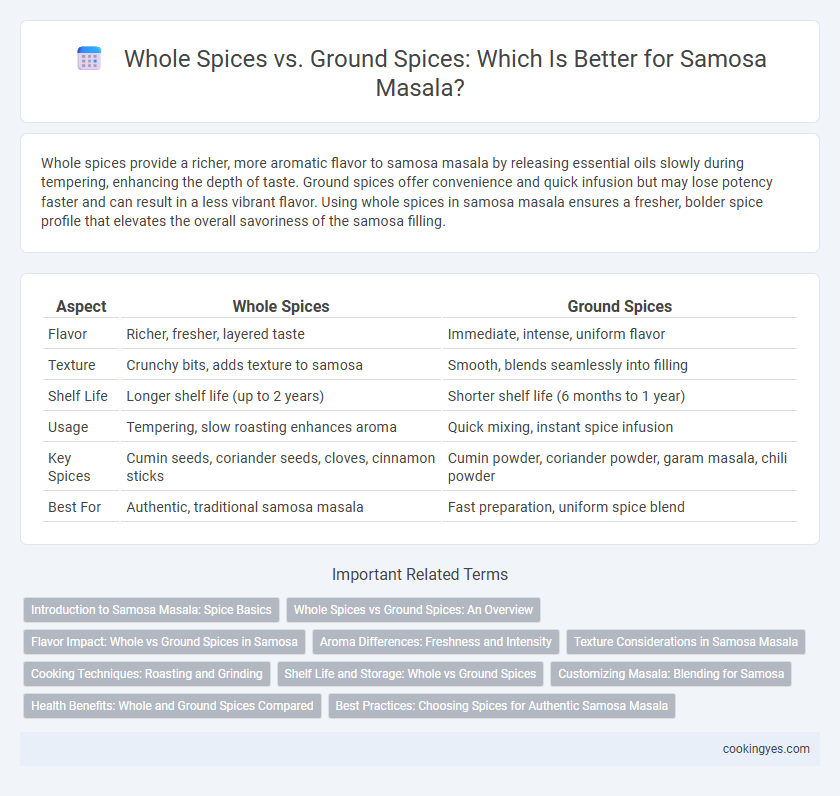Whole spices provide a richer, more aromatic flavor to samosa masala by releasing essential oils slowly during tempering, enhancing the depth of taste. Ground spices offer convenience and quick infusion but may lose potency faster and can result in a less vibrant flavor. Using whole spices in samosa masala ensures a fresher, bolder spice profile that elevates the overall savoriness of the samosa filling.
Table of Comparison
| Aspect | Whole Spices | Ground Spices |
|---|---|---|
| Flavor | Richer, fresher, layered taste | Immediate, intense, uniform flavor |
| Texture | Crunchy bits, adds texture to samosa | Smooth, blends seamlessly into filling |
| Shelf Life | Longer shelf life (up to 2 years) | Shorter shelf life (6 months to 1 year) |
| Usage | Tempering, slow roasting enhances aroma | Quick mixing, instant spice infusion |
| Key Spices | Cumin seeds, coriander seeds, cloves, cinnamon sticks | Cumin powder, coriander powder, garam masala, chili powder |
| Best For | Authentic, traditional samosa masala | Fast preparation, uniform spice blend |
Introduction to Samosa Masala: Spice Basics
Whole spices such as cumin seeds, coriander seeds, and fennel seeds are favored in samosa masala for their robust aroma and ability to release flavor gradually when toasted. Ground spices, including ground turmeric, red chili powder, and garam masala, provide immediate intensity and uniformity in the spice blend. Combining whole and ground spices creates a balanced samosa masala that enhances both the depth and complexity of the filling.
Whole Spices vs Ground Spices: An Overview
Whole spices retain essential oils and aromas longer than ground spices, making them ideal for tempering samosa masala to enhance flavor bursts and freshness. Ground spices provide convenience and a uniform texture but may lose potency quickly due to increased surface area exposure to air. Using whole spices like cumin seeds, cloves, and cinnamon sticks in samosa masala ensures a richer, more vibrant taste profile, especially when freshly roasted or tempered before grinding or mixing.
Flavor Impact: Whole vs Ground Spices in Samosa
Whole spices in samosa masala release a slow, intense aroma and provide a layered, robust flavor as they toast in oil, enhancing the overall taste complexity. Ground spices deliver a quick, potent burst of flavor but can lose their fragrance rapidly during cooking, often resulting in a less nuanced spice profile. The choice between whole and ground spices directly affects the depth, freshness, and intensity of the samosa's signature taste.
Aroma Differences: Freshness and Intensity
Whole spices in samosa masala release a vibrant and intense aroma when toasted, preserving essential oils that evaporate quickly in ground form. Ground spices offer convenience but often lack the fresh, robust fragrance integral to authentic samosa flavors due to faster oxidation. Using freshly ground whole spices ensures a deeper, more complex aroma that elevates the savory experience of samosas.
Texture Considerations in Samosa Masala
Whole spices in samosa masala provide a coarser texture and release bursts of flavor during frying, enhancing the crispiness of the samosa exterior. Ground spices create a uniform, fine texture that evenly blends into the filling, delivering consistent seasoning but less impact on crunch. Balancing whole and ground spices optimizes the texture by combining aromatic intensity with a harmonious mouthfeel inside the samosa.
Cooking Techniques: Roasting and Grinding
Roasting whole spices like cumin, coriander, and fennel seeds before grinding enhances the flavor profile of samosa masala by releasing essential oils and intensifying aroma. Grinding freshly roasted spices ensures a vibrant, robust taste compared to pre-ground powders, which can lose potency over time. Using traditional mortar and pestle or electric grinders allows control over texture, contributing to the perfect balance of spice and heat in samosa fillings.
Shelf Life and Storage: Whole vs Ground Spices
Whole spices for samosa masala maintain potency and aroma longer than ground spices due to reduced surface area exposure, typically lasting up to 3-4 years when stored in airtight containers away from light and moisture. Ground spices degrade faster, often losing flavor within 6-12 months, and require airtight, cool storage to slow oxidation. Using whole spices ground fresh ensures maximum shelf life, vibrant aroma, and optimal flavor in samosa masala blends.
Customizing Masala: Blending for Samosa
Using whole spices for samosa masala allows for a fresher, more aromatic blend, as the spices release essential oils when roasted and ground just before mixing. Ground spices offer convenience and uniform consistency but may lack the depth and complexity compared to freshly ground whole spices. Customizing samosa masala by combining freshly roasted whole spices such as cumin, coriander, and fennel seeds ensures a vibrant, flavorful filling that enhances every bite.
Health Benefits: Whole and Ground Spices Compared
Whole spices in samosa masala retain essential oils and antioxidants better than ground spices, offering enhanced anti-inflammatory and digestive benefits. Ground spices release flavor quickly but may lose potency and health-enhancing compounds over time due to greater surface exposure. Choosing whole spices ensures maximum nutrient retention, promoting improved metabolism and immune support in samosa preparations.
Best Practices: Choosing Spices for Authentic Samosa Masala
Whole spices such as cumin seeds, coriander seeds, and cloves retain their essential oils longer, providing fresher, more intense flavors when toasted and ground just before use in samosa masala. Ground spices offer convenience but can lose potency and aroma over time, leading to a less vibrant taste in the filling. For authentic samosa masala, best practices include preferring whole spices to maximize flavor complexity and grinding them fresh to enhance the traditional and aromatic profile of the dish.
Whole spices vs Ground spices for samosa masala Infographic

 cookingyes.com
cookingyes.com